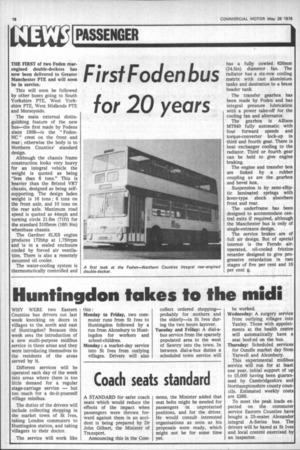First Foden bus for 20 years
Page 18

If you've noticed an error in this article please click here to report it so we can fix it.
THE FIRST of two Foden rearengined double-deckers has now been delivered to Greater Manchester PTE and will soon be in service.
This will soon be followed by other buses going to South Yorkshire PTE, West Yorkshire PTE, West Midlands PTE and Merseyside.
The main external distinguishing feature of the new bus—the first made by Fodens since 1956—is the " FodenNC " crest on the front and rear ; otherwise the body is to Northern Counties' standard design.
Although the chassis frame construction looks very heavy for an integral vehicle the weight is quoted as being "less than 6 tons." This is heavier than the Bristol VRT chassis, designed as being selfsupporting. The design laden weight is 16 tons ; 6 tons on the front axle, and 10 tons on the rear axle. Maximum road speed is quoted as 44mph and turning circle 21.6m (71ft) for the standard 5105mm (I6ft 9in) wheelbase chassis.
The Gardner 6LXB engine produces 172bhp at 1,750rpm and is in a sealed enclosure cooled by forced air ventilation. There is also a remotely mounted oil cooler.
The water-cooling system is thermostatically controlled and has a fully cowled 620mm (24.5in) diameter fan. The radiator has a six-row cooling matrix with cast aluminium tanks and deairation to a brass header tank.
The transfer gearbox has been made by Foden and has integral pressure lubrication with a power take-off for the cooling fan and alternator.
The gearbox is Allison MT640 fully automatic with four forward speeds and torque-converter lock-up in third and fourth gear. There is heat exchanger cooling to the radiator. Third or fourth gear can be held to give engine braking.
The engine and transfer box are linked by a rubber coupling as are the gearbox and bevel box.
Suspension is by semi-elliptic laminated springs with lever-type shock absorbers front and rear.
The underframe has been designed to accommodate central exits if required, although the Manchester bus is only of single-entrance design.
The service brakes are of full air design. But of special interest is the Ferodo airoperated, oil-cooled friction retarder designed to give progressive retardation in two stages of five per cent and 10 per cent g.




















































































